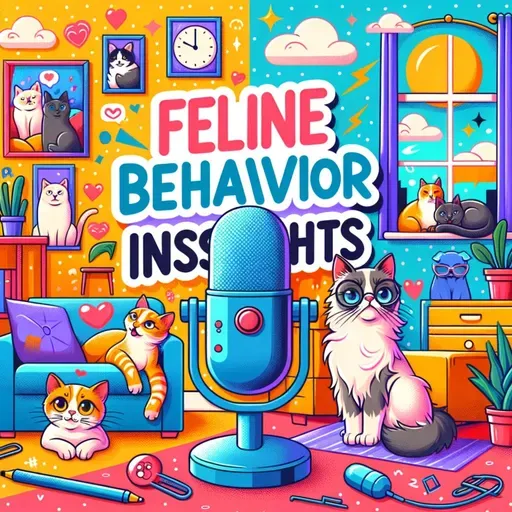
26 September 2025
Understanding Feline Behavior: Decoding Purrs, Kneads, and Body Language
Feline Behavior Insights
About
Feline behavior remains endlessly fascinating, revealing complex communication, emotions, and instincts. Listeners may have noticed their cats purring, kneading, or grooming—these common behaviors vary widely from cat to cat and stem from both unique personalities and careful evolutionary design. According to Pets Best, cats purr when content or even to self-soothe during stress, while kneading their paws is leftover from kittenhood—a signal of comfort tied to nursing. Grooming also carries meaning, with excessive licking often pointing to stress or medical issues, while routine cleaning is all about hygiene and social bonding.
Body language gives powerful insight into how cats feel moment to moment. The team at PetMD highlights that a relaxed cat will stretch out, show a loose body, and may even expose its belly—a surprisingly vulnerable gesture that signals trust but is rarely an open invitation for belly rubs. Slow blinking is a sign of trust and affection; listeners can try returning the gesture for a friendly connection. Happy cats hold their ears upright, narrow their pupils, and may curl their tail at the tip, signaling confidence and ease.
Cat communication is not just vocal. According to Wikipedia’s guide to cat communication, felines use an array of postures to express everything from aggression and confidence to fear or tension. A high, rigid tail makes a cat appear larger, showing confidence or warning others away, while a tucked or low tail means fear or submission. Aggression appears with arched backs, puffed fur, and ears pulled back—signs cats use to avoid actual conflict.
Playful behavior is rooted in a cat’s predatory instincts. PetMD notes that a playful cat will crouch, wiggle their rear, chase, and pounce, mimicking hunting tactics. Their eyes widen and their pupils may dilate, evidence of excitement at the game.
Scratching is another universal feline act, explained by Pets Best as both a way to maintain nail health and mark territory. Furniture or walls can suffer, but providing enticing scratching posts and redirecting attention can spare a household from destructive clawing. Double-sided tape or aluminum foil on problem spots will discourage scratching, helping your cat develop better habits.
Curiosity is perhaps the defining feline trait. Whether loafing in a perfect circle to retain warmth or batting objects off tables just to see the reaction, cats use play and exploration to gather information about their world. According to Tuft & Paw, even tail movements tell stories. A rapidly quivering tail may indicate happy anticipation or even the intention to mark territory.
Feline behavior is a dynamic blend of instinct, emotion, and social signals. By observing the nuances—from a slow blink to playful pounce—listeners deepen the connection with their cats and support their well-being. Thanks for tuning in, and don’t forget to subscribe. This has been a quiet please production, for more check out quiet please dot ai.
For more http://www.quietplease.ai
Get the best deals https://amzn.to/3ODvOta
This content was created in partnership and with the help of Artificial Intelligence AI
Body language gives powerful insight into how cats feel moment to moment. The team at PetMD highlights that a relaxed cat will stretch out, show a loose body, and may even expose its belly—a surprisingly vulnerable gesture that signals trust but is rarely an open invitation for belly rubs. Slow blinking is a sign of trust and affection; listeners can try returning the gesture for a friendly connection. Happy cats hold their ears upright, narrow their pupils, and may curl their tail at the tip, signaling confidence and ease.
Cat communication is not just vocal. According to Wikipedia’s guide to cat communication, felines use an array of postures to express everything from aggression and confidence to fear or tension. A high, rigid tail makes a cat appear larger, showing confidence or warning others away, while a tucked or low tail means fear or submission. Aggression appears with arched backs, puffed fur, and ears pulled back—signs cats use to avoid actual conflict.
Playful behavior is rooted in a cat’s predatory instincts. PetMD notes that a playful cat will crouch, wiggle their rear, chase, and pounce, mimicking hunting tactics. Their eyes widen and their pupils may dilate, evidence of excitement at the game.
Scratching is another universal feline act, explained by Pets Best as both a way to maintain nail health and mark territory. Furniture or walls can suffer, but providing enticing scratching posts and redirecting attention can spare a household from destructive clawing. Double-sided tape or aluminum foil on problem spots will discourage scratching, helping your cat develop better habits.
Curiosity is perhaps the defining feline trait. Whether loafing in a perfect circle to retain warmth or batting objects off tables just to see the reaction, cats use play and exploration to gather information about their world. According to Tuft & Paw, even tail movements tell stories. A rapidly quivering tail may indicate happy anticipation or even the intention to mark territory.
Feline behavior is a dynamic blend of instinct, emotion, and social signals. By observing the nuances—from a slow blink to playful pounce—listeners deepen the connection with their cats and support their well-being. Thanks for tuning in, and don’t forget to subscribe. This has been a quiet please production, for more check out quiet please dot ai.
For more http://www.quietplease.ai
Get the best deals https://amzn.to/3ODvOta
This content was created in partnership and with the help of Artificial Intelligence AI